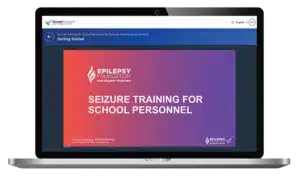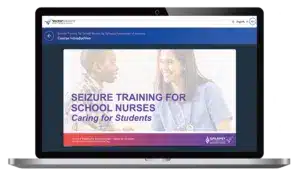August 28, 2023 1 min read

Supporting Students with Seizure Disorder: What Your School Needs to Know
Industry:
Solution:

Vector Solutions Offers Course from Epilepsy Foundation of America to Help Schools Comply with Seizure Training Mandates
More than 470,000 children in the United States – roughly 6 out of every 1,000 K-12 students, are living with epilepsy, a disease or disorder of the brain which causes reoccurring seizures. The American Association of Pediatrics lists seizures as the third most common school emergency, making it a significant concern for schools.
Keeping students with seizure disorders safe in schools requires making sure staff members know what to do when incidents occur. To that end, nearly half of U.S. states have enacted “Seizure Safe Schools” legislation – laws which require all K-12 school personnel, including school nurses and teachers, to complete training so they can recognize and respond appropriately and efficiently to students experiencing seizures.
To support schools in offering this training for their staff members, Vector Solutions has partnered with the Epilepsy Foundation to add the Epilepsy Foundation’s online courses to its Safety and Compliance course library, making it accessible to more K-12 schools.

About the Courses
Seizure Training for School Personnel
This course provides an overview of seizures and epilepsy, seizure first aid, seizure action plans, rescue therapies, seizure emergencies and how to support students in school settings. This course is appropriate for school nurses, teachers, aides, coaches, administrators and anyone who works in a school setting.
It teaches participants how to:
- Recognize common seizure types (focal onset, generalized onset or unknown onset)
- Describe first aid steps to assist a student having a seizure
- Recognize the key factors that would make a seizure a medical emergency
- Support students living with epilepsy

Seizure Training for School Nurses: Caring for Students
This course provides the school nurse with information, strategies, and resources to enable them to better manage a student with seizures by supporting positive treatment outcomes, maximizing educational and developmental opportunities, and ensuring a safe and supportive environment. The program consists of seven modules to assist the school nurse in learning to effectively manage seizures in a school environment.
The course helps participants:
- Identify two of the most common seizure types in students with epilepsy, potential triggers, and risk factors for seizures and emergencies
- Identify how treatment of epilepsy may affect a student’s health, safety or learning
- Apply strategies to alleviate psychosocial challenges relating to epilepsy for students, parents, and school personnel
- Learn how to perform first aid on students during and after a seizure
- Create a Seizure Action Plan for a student with epilepsy using safe practices for medication administration and delegation
Seizure First Aid Ready (Coming Soon)
This course educates the public on the Epilepsy Foundation’s basic procedures for responding to someone having a seizure. The on-demand course is presented in an interactive format with animations, videos, and activities to help everyone become Seizure First Aid ready. Participants who successfully complete the training will receive a certificate of completion. This is not a certification course.
All three courses are available in Vector’s Safety & Compliance library for K-12 schools, and the Seizure First Aid Ready course will also be available in Vector’s Health and Human Safety library for higher education faculty and staff. They’re available online, and are accessible from any device which allows for more flexibility for schools and staff members in terms of scheduling.
Seizure Awareness and Prevention
Staff training should be just one part of a larger, more comprehensive plan to support students who have seizure disorders. According to the CDC, managing epilepsy while at school may involve:
- Educating the school nurse, teachers, staff, and students about epilepsy and its treatment, seizure first aid, and possible stigma associated with epilepsy
- Following the seizure action plan and administering first aid (including the use of rescue medications)
- Understanding the importance of medication adherence and supporting students who take daily medications
- Helping students avoid seizure triggers, such as flashing lights, or other triggers identified in the seizure action plan
- Monitoring and addressing any related medical conditions, including mental health concerns such as depression
- Providing case management services for students whose medical condition disrupts their school attendance or academic performance
- Referring students with uncontrolled seizures to medical services within the community or to the Epilepsy Foundation for more information
- Understanding the laws related to disability, medical conditions, and special education to ensure that children with epilepsy are able to access the free and appropriate education afforded to them under the law
- Monitoring student behavior to prevent bullying of students with epilepsy
The Epilepsy Foundation’s Seizure Safe Schools model legislation for states recommends a total of five key components:
- Requiring school personnel to complete seizure recognition and first-aid response training
- Mandating that the Seizure Action Plan is made part of the student’s file and made available for school personnel and volunteers responsible for the student
- Ensuring that any FDA-approved medication prescribed by the treating physician is administered to the student living with epilepsy
- Educating and training students about epilepsy and first-aid response
- Having a Good Samaritan clause
The number of components included will vary by state, but to date, 23 states have enacted Seizure Safe Schools legislation that 1) mandates school personnel to complete seizure recognition and first aid training, 2) requires students with epilepsy to have a Seizure Action Plan on file, and/or 3) requires administration of Food and Drug Administration (FDA)-approved treatments in the school setting.
Several other states have passed bills or resolutions that raise awareness about the need for Seizure Safe Schools and/or encourage epilepsy- and seizure-related training, and many states are laying the groundwork for Seizure Safe Schools bills or have even introduced bills.
Seizure disorders can often be managed effectively with medication, but seizures still occur and schools must be prepared. By training staff members about understanding seizure disorders and how to respond quickly and effectively, school administrators can help make their schools safer places for students with seizure disorders which will help with both safety, and peace of mind.
For more information about Vector Solutions partnership with the Epilepsy Foundation, visit https://www.vectorsolutions.com/resources/press-releases/epilepsy-foundation-partners-with-vector-solutions-to-offer-seizure-first-aid-trainings-to-educators/
For more information about the new seizure training courses, visit https://info.vectorsolutions.com/vs-k12-epilepsy










